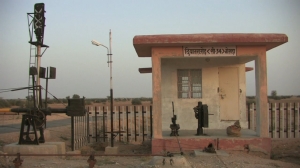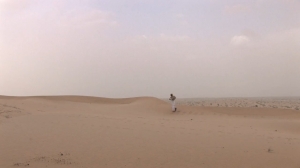I was fortunate enough to be able to watch Letters from the Desert (Eulogy to Slowness) yesterday. It’s a poetic documentary by Italian director Michela Occhipinti. While other slow films, that have been widely discussed, are seen in the light of slow vs fast because we project it onto them, Occhipinti’s film is addressing this topic directly. It is the only slow film, to my knowledge, that can be regarded as an explicit stance in the slow-fast-dialogue.
Letters tells the story of a postman in an Indian region which is still very much true to its (untouched) nature. The film starts with images of a bustling city. The camera is in constant movement, the cuts are fast. The noise is overwhelming. A young man writes a letter, and we go on a journey with a train. The train’s sound, again, is overwhelming. It’s juxtaposed with images of the Indian landscape; vast, natural spaces. Quiet spaces. Quiet spaces you are, in fact, longing for as a viewer after having been through all this noise. The train rushes past a station, and what follows is one of the most remarkable transition I’ve seen in film: the camera remains with the station, and once the train has passed, we hear nothing but silence. It’s auditory beauty, if you wish, and you go “ahhh, finally!” in your head. Then we cut to a postman on his bicycle.
Fom this moment onwards we’re traveling with him through the desert to deliver letters. In many scenes he appears to be a small, lonely figure surrounded by the vast desert around him. It’s beautifully photographic, and highlights the interplay of space and man; an interplay that shapes both.
A mobile tower is erected in his village, which is the beginning of the end of his job. It changes both the natural landscape and the landscape of communication. People write less and less letters. “Letters are more expensive, and they take longer.” People don’t have time, or rather they have been given a medium that delivers messages much faster and they are happy to save a bit of time. Towards the end of the film, the postman has a mere two letters in his bag. A third one announces that there would be job cuts due to the declining numbers of letters sent. He is forced to open a market stall in order to support his family, as his salary isn’t sufficient anymore.
There is more to this film, however, than a simple statement about the effects of modernity arriving in even the remotest areas. There is also more than it photographic beauty. Overall, the film is multi-layered and addresses several issues.
There is, for instance, an underlying theme of illiteracy apparent. In many cases, the postman reads out the letters as the recipients cannot read. It thus blurs the line between private and public. And yet, it is a ceremonial event. Usually the whole family gathers together when a letter is read. This is changing with the arrival of mobile phones. Ironically, the postman himself, while struggling with a declining salary, receives a mobile phone by post, which his son has bought for him with his savings. This sets up a poignant juxtaposition.
Earlier in the film, he had received a letter from him and the whole family was around to listen to what he said. But when he phoned his son, he was alone. High up on his house’s walls in order to receive a better signal. It feels as if communication has been reduced to mere technicalities.
Interestingly, the son cannot talk at that moment. He is busy, and his father has to hung up. Besides, the signal isn’t allowing for a smooth communication.
A letter would have made it possible to communicate…


